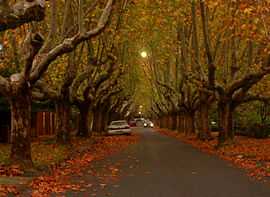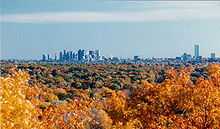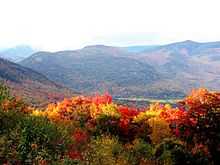Autumn

| Part of the nature series |
| Weather |
|---|
| Calendar seasons |
| Tropical seasons |
| Storms |
| Precipitation |
| Topics |
| Weather portal |
Autumn, interchangeably known as fall in North America,[1] is one of the four temperate seasons. Autumn marks the transition from summer into winter, in September (Northern Hemisphere) or March (Southern Hemisphere), when the arrival of night becomes noticeably earlier and the temperature cools considerably. One of its main features is the shedding of leaves from deciduous trees.
Some cultures regard the autumnal equinox as "mid-autumn", while others with a longer temperature lag treat it as the start of autumn.[2] Meteorologists (and most of the temperate countries in the southern hemisphere)[3] use a definition based on months, with autumn being September, October and November in the northern hemisphere,[4] and March, April and May in the southern hemisphere.
In North America, autumn is usually considered to start with the September equinox[5] and end with the winter solstice (21 or 22 December).[6] In traditional East Asian solar term, autumn starts on or around 8 August and ends on or about 7 November. In Ireland, the autumn months according to the national meteorological service, Met Éireann, are September, October and November.[7] However, according to the Irish Calendar, which is based on ancient Gaelic traditions, autumn lasts throughout the months of August, September and October, or possibly a few days later, depending on tradition. In Australia and New Zealand, autumn officially begins on 1 March and ends on 31 May.[8]
Etymology

The word autumn comes from the ancient Etruscan root autu- and has within it connotations of the passing of the year.[9] It was borrowed by the neighbouring Romans, and became the Latin word autumnus.[10] After the Roman era the word continued to be used as the Old French word autompne (automne in modern French), and was later normalised to the original Latin. In the Medieval period there are rare examples of its use as early as the 12th century, but by the 16th century it was in common use.

Before the 16th century, harvest was the term usually used to refer to the season, as it is common in other West Germanic languages to this day (cf. Dutch herfst, German Herbst and Scots hairst). However, as more people gradually moved from working the land to living in towns, the word harvest lost its reference to the time of year and came to refer only to the actual activity of reaping, and autumn, as well as fall, began to replace it as a reference to the season.[11][12]
The alternative word fall for the season traces its origins to old Germanic languages. The exact derivation is unclear, with the Old English fiæll or feallan and the Old Norse fall all being possible candidates. However, these words all have the meaning "to fall from a height" and are clearly derived either from a common root or from each other. The term came to denote the season in 16th century England, a contraction of Middle English expressions like "fall of the leaf" and "fall of the year".[13]
During the 17th century, English emigration to the British colonies in North America was at its peak, and the new settlers took the English language with them. While the term fall gradually became obsolete in Britain, it became the more common term in North America.
Associations
Harvest
.jpg)
Association with the transition from warm to cold weather, and its related status as the season of the primary harvest, has dominated its themes and popular images. In Western cultures, personifications of autumn are usually pretty, well-fed females adorned with fruits, vegetables and grains that ripen at this time. Many cultures feature autumnal harvest festivals, often the most important on their calendars. Still extant echoes of these celebrations are found in the autumn Thanksgiving holiday of the United States and Canada, and the Jewish Sukkot holiday with its roots as a full-moon harvest festival of "tabernacles" (living in outdoor huts around the time of harvest). There are also the many North American Indian festivals tied to harvest of autumnally ripe foods gathered in the wild, the Chinese Mid-Autumn or Moon festival, and many others. The predominant mood of these autumnal celebrations is a gladness for the fruits of the earth mixed with a certain melancholy linked to the imminent arrival of harsh weather.
This view is presented in English poet John Keats' poem To Autumn, where he describes the season as a time of bounteous fecundity, a time of 'mellow fruitfulness'.
While most foods are harvested during the autumn, foods particularly associated with the season include pumpkins (which are integral parts of both Thanksgiving and Halloween) and apples, which are used to make the seasonal beverage apple cider.
Melancholy

Autumn in poetry has often been associated with melancholy. The possibilities of summer are gone, and the chill of winter is on the horizon. Skies turn grey, and many people turn inward, both physically and mentally.[14] It has been referred to as an unhealthy season.[15]
Similar examples may be found in Irish poet William Butler Yeats' poem The Wild Swans at Coole where the maturing season that the poet observes symbolically represents his own ageing self. Like the natural world that he observes he too has reached his prime and now must look forward to the inevitability of old age and death. French poet Paul Verlaine's "Chanson d'automne" ("Autumn Song") is likewise characterised by strong, painful feelings of sorrow. Keats' To Autumn, written in September 1819, echoes this sense of melancholic reflection, but also emphasises the lush abundance of the season.
Other associations
Autumn is associated with the Halloween season (influenced by Samhain, a Celtic autumn festival),[16] and with it a widespread marketing campaign that promotes it, in the United States. The television, film, book, costume, home decoration, and confectionery industries use this time of year to promote products closely associated with such a holiday, with promotions going from early September to 31 October, since their themes rapidly lose strength once the holiday ends, and advertising starts concentrating on Christmas.
Television stations and networks, particularly in North America, traditionally begin their regular seasons in autumn, with new series and new episodes of existing series debuting mostly during late September or early October (series that debut outside the fall season are usually known as midseason replacements). A sweeps period takes place in November to measure Nielsen Ratings.
Autumn, particularly in most parts of the United States and Canada, also has a strong association with the start of a new school year, particularly for children in primary and secondary education. "Back to School" advertising and preparations usually occurs in the weeks leading to the start of the fall season. Also, Autumn in the Southern Hemisphere is the Easter season.
Since 1997, Autumn has been one of the top 100 names for girls in the United States.[17]
In Indian mythology, autumn is considered to be the preferred season for the goddess of learning Saraswati, who is also known by the name of "goddess of autumn" (Sharada).
In Asian mysticism, Autumn is associated with the element of metal, and subsequently with the colour white, the White Tiger of the West, and death and mourning.
Tourism
.jpg)
Although colour change in leaves occurs wherever deciduous trees are found, coloured autumn foliage is noted in various regions of the world: most of North America, Eastern Asia (including China, Korea, and Japan), Europe, the forest of Patagonia, eastern Australia and New Zealand's South Island.
Eastern Canada and New England are famous for their autumnal foliage,[18][19] and this attracts major tourism (worth billions of U.S. dollars) for the regions.[20][21]
Paintings
-

Otoño, Frederic Edwin Church, 1875. Museo Thyssen-Bornemisza[1]
-

John Everett Millais, "Autumn Leaves".
-

Early Autumn, Qian Xuan, 13th century, depiction of decaying lotus leaves and dragonflies hovering over stagnant water
-

Autumn, Giuseppe Arcimboldo, 1573
-
.jpg)
Herbst [Autumn], Meinolf Wewel
- ^ CM; Paloma. Alarcó. "Autumn - Frederic Edwin Church | Museo Thyssen". museothyssen.org. Madrid, Spain: Thyssen-Bornemisza Museum. Retrieved 10 October 2012.
Image gallery
-

Cherry trees in autumn
-

Oak tree in autumn
-

A forested hill over Struma (river) valley in Vitosha, Bulgaria
-

Leaves of the Maple tree in autumn.
-
.jpg)
Paysage d'automne
-
.jpg)
Gardens of Schönbrunn in autumn
-
.jpg)
Gardens of Schönbrunn in autumn
-

Birch trees in autumn. Estonia
-
Tree in New Jersey
-

Red coloration of leaves in autumn
See also
References
 This article incorporates text from a publication now in the public domain: Chambers, Ephraim, ed. (1728). "article name needed". Cyclopædia, or an Universal Dictionary of Arts and Sciences (first ed.). James and John Knapton, et al.
This article incorporates text from a publication now in the public domain: Chambers, Ephraim, ed. (1728). "article name needed". Cyclopædia, or an Universal Dictionary of Arts and Sciences (first ed.). James and John Knapton, et al.
- ↑ "Oxford Dictionary on the North American usage of Fall".
- ↑ "NOAA's National Weather Service - Glossary". Crh.noaa.gov. Retrieved 2010-08-06.
- ↑ "New Zealand Weather and Climate, New Zealand Weather, Temperatures and Climate in New Zealand". Tourism.net.nz. Retrieved 2010-08-06.
- ↑ "Weather Centre - Features - Understanding Weather - Autumn Forecasting". BBC. Archived from the original on 4 September 2010. Retrieved 2010-08-06.
- ↑ Kanalley, Craig (22 September 2010). "First Day Of Fall 2010: Autumn Equinox Photos". Huffingtonpost.com. Archived from the original on 24 September 2010. Retrieved 2010-09-22.
- ↑ http://www.almanac.com/content/first-day-winter-winter-solstice
- ↑ "The Weather of Autumn 2007 (September, October & November summary)" (PDF). Met Éireann - The Irish Meteorological Service Online. 3 December 2007. Retrieved 10 October 2012.
- ↑ "So when do we actually start the seasons?". Museumvictoria.com.au. Archived from the original on 2010-09-03. Retrieved 2010-08-06.
- ↑ Breyer, Gertraud (1993). Etruskisches Sprachgut im Lateinischen unter Ausschluss des spezifisch onomastischen Bereiches (in German). Peeters Publishers. pp. 412–413. ISBN 9068313355.
- ↑ Etymology of 'autumn' - New Shorter Oxford English Dictionary, 1997 Edition
- ↑ Harper, Douglas. "harvest". Online Etymology Dictionary.
- ↑ Harper, Douglas. "autumn". Online Etymology Dictionary.
- ↑ Harper, Douglas. "fall". Online Etymology Dictionary.
- ↑ Cyclical Regenerative Time - (c) Autumn (from 'Symbolism of Place', symbolism.org website)
- ↑ D'Alembert, Jean Le Rond (2013) [1751]. Holtrop, Ellen, ed. "Autumn". The Encyclopedia of Diderot & d'Alembert Collaborative Translation Project. Michigan Publishing. Retrieved 31 March 2015.
- ↑ "Halloween". Encarta. Microsoft. Archived from the original on 2009-10-31.
- ↑ Popular Baby Names, Social Security Online.
- ↑ "Nova Scotia Capitalizes on Fall Tourism | News Releases | Government of Nova Scotia". Gov.ns.ca. 21 September 1999. Retrieved 2010-03-06.
- ↑ Ross, Ben (14 September 2002). "The Complete Guide to Leaf-Peeping - News & Advice, Travel". London: The Independent. Retrieved 2010-03-06.
- ↑ Shir Haberman. "Leaf peepers storm N.H., Maine". SeacoastOnline.com. Retrieved 2010-03-06.
- ↑ "Record New England Rains Make Foliage `a Dud,' Hurt Tourism". Bloomberg.com. 4 November 2005. Retrieved 2010-03-06.
External links
| Look up autumn or fall in Wiktionary, the free dictionary. |
- How To Photograph Autumn Color
-
 Media related to Autumn at Wikimedia Commons
Media related to Autumn at Wikimedia Commons -
 Quotations related to Fall at Wikiquote
Quotations related to Fall at Wikiquote
| ||||||||||||||||

